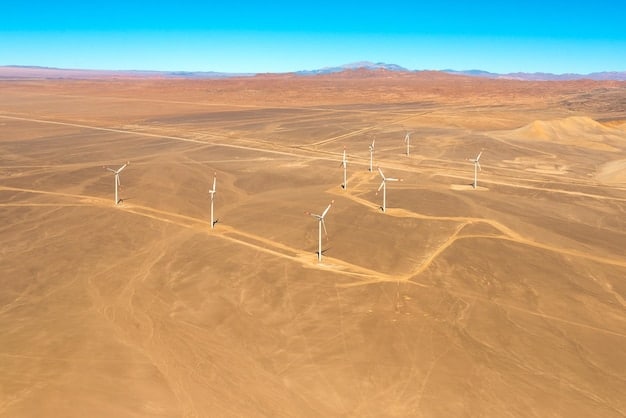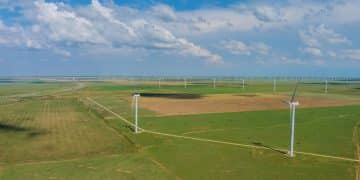US states leading renewable energy adoption: a comparative analysis

A detailed comparison reveals how certain US states are significantly advancing in renewable energy adoption, driven by diverse policy frameworks, geographic advantages, and economic incentives that foster a sustainable energy future.
The push for a sustainable future has brought renewable energy to the forefront of national discussions. Understanding which US states are leading the way in renewable energy adoption and why is crucial for policy makers, investors, and anyone interested in sustainable development. This analysis delves into the diverse approaches and unique advantages that propel certain regions ahead in the green energy transition.
the landscape of renewable energy in the US
The United States’ energy landscape is undergoing a significant transformation, with renewable sources steadily increasing their share in the national grid. This shift is not uniform across states; rather, it’s a mosaic of progress driven by various factors. Understanding this variability requires a look at both the overall picture and the nuances within individual states’ energy strategies.
The transition toward renewables is multifaceted, encompassing solar, wind, hydro, geothermal, and biomass. Each of these technologies presents unique opportunities and challenges depending on geographical location, resource availability, and technological advancements. The national trajectory indicates a clear move away from traditional fossil fuels, spurred by environmental concerns, energy independence goals, and the falling costs of renewable technologies.
national trends and statistics
In recent years, the installed capacity of renewable energy in the US has seen unprecedented growth. Wind and solar power, in particular, have emerged as dominant forces, largely due to federal incentives and technological innovations that have made them more competitive. This growth is evident in the increasing percentage of electricity generated from renewables across the country.
- Increased Investment: Significant private and public investment is flowing into renewable energy projects, indicating strong market confidence.
- Cost Reductions: The levelized cost of energy (LCOE) for solar and wind has dropped dramatically, making them often cheaper than new fossil fuel plants.
- Grid Modernization: Investments in smart grids and energy storage solutions are crucial for integrating intermittent renewable sources effectively.
Despite these positive trends, challenges remain. The intermittency of some renewable sources, the need for robust transmission infrastructure, and policy uncertainty at various levels can hinder progress. However, the overarching momentum suggests that renewables will continue to play an increasingly vital role in meeting the nation’s energy demands.
The diverse geography of the US naturally lends itself to different types of renewable energy. For instance, the sunny Southwest is ideal for solar power, while the windy Great Plains are perfect for wind farms. States are leveraging these natural endowments to maximize their renewable energy potential, often resulting in specialized renewable energy economies.
Overall, the US renewable energy landscape is dynamic and evolving. While the path to a fully renewable grid is long, the current trends indicate a strong commitment from various stakeholders to accelerate the adoption of clean energy technologies. This foundation sets the stage for a deeper dive into the specific states making significant strides.
california: a trailblazer in renewable energy
California stands as a global leader in renewable energy adoption, consistently setting ambitious targets and implementing innovative policies. Its comprehensive approach to green energy encompasses a wide range of technologies and a robust policy framework designed to transition the state away from fossil fuels. This commitment has positioned California not just as an environmental advocate, but also as an economic powerhouse in the clean energy sector.
The state’s aggressive renewable portfolio standards (RPS) have been instrumental in driving its success. California aims for 100% clean electricity by 2045, a goal that many other states and nations are now attempting to emulate. This target requires significant investment and technological advancement, pushing the boundaries of what’s possible in renewable integration.
policy and regulatory frameworks
California’s regulatory environment is arguably one of the most proactive in the nation when it comes to renewable energy. The state has enacted numerous laws and incentives that favor renewable power generation and discourage fossil fuel use. These policies create a stable and attractive market for renewable energy developers and investors.
- Renewable Portfolio Standard (RPS): Mandates that a certain percentage of electricity come from renewable sources, progressively increasing over time.
- Cap-and-Trade Program: Limits greenhouse gas emissions from various sectors, providing financial incentives for cleaner operations.
- Net Metering Policies: Encourage rooftop solar adoption by allowing customers to sell excess electricity back to the grid.
Beyond these, California heavily invests in research and development for emerging clean energy technologies, including advanced battery storage and smart grid infrastructure. This forward-thinking approach ensures that the state remains at the cutting edge of renewable energy innovation, addressing challenges like intermittency and grid stability.

The state’s political will and public support for environmental protection further solidify its leadership position. California’s population is generally highly aware of climate change issues and supportive of policies that promote sustainability, creating a fertile ground for renewable energy initiatives to thrive.
While challenges such as grid stability and the integration of large-scale renewable projects persist, California’s experience offers valuable lessons for other states. Its success demonstrates that ambitious renewable targets, coupled with strong policy and strategic investment, can indeed lead to a rapid and sustainable energy transformation, paving the way for a greener future nationwide.
texas: unexpected renewable powerhouse
Often associated with oil and gas, Texas has quietly emerged as an unexpected leader in renewable energy, particularly wind power. This dual identity highlights a fascinating aspect of the US energy transition: even states rich in traditional fossil fuels can embrace and significantly contribute to the renewable sector. Texas’s vast land area, favorable wind resources, and deregulated energy market have created a unique environment for explosive growth in renewable energy capacity.
The state leads the nation in wind energy generation, boasting an impressive installed capacity that surpasses many countries. This rapid expansion is not solely driven by environmental mandates but largely by market forces and economic pragmatism. Wind power in Texas has become increasingly cost-competitive, attracting significant private investment and creating numerous jobs within the renewable energy sector.
market forces and grid modernization
Unlike California, Texas’s renewable energy boom has been less driven by stringent government mandates and more by a competitive energy market and abundant natural resources. The state’s independent grid, ERCOT (Electric Reliability Council of Texas), facilitates direct competition among power generators, which has inadvertently favored the cheapest sources, often wind, and increasingly, solar.
- Abundant Wind Resources: The “wind corridor” of West Texas offers some of the best wind conditions globally, making it ideal for large-scale wind farms.
- Deregulated Market: The competitive market structure allows renewable energy projects to thrive based on economic viability rather than solely on subsidies.
- Infrastructure Investment: Significant investments in transmission infrastructure, such as the Competitive Renewable Energy Zones (CREZ) lines, have been crucial for delivering wind power from rural areas to urban centers.
More recently, solar power has also begun to gain significant traction in Texas, complementing the existing wind infrastructure. The dual growth of wind and solar offers an attractive combination, as their peak generation times often differ, helping to balance the grid more effectively. This diversified renewable portfolio enhances overall grid reliability and resilience.
Texas’s example demonstrates that economic incentives coupled with geographical advantages can be powerful drivers for renewable energy adoption. While the state still produces significant amounts of fossil fuels, its robust renewable energy sector showcases a pragmatic approach to energy diversification. This model offers valuable insights for other states that may not have aggressive renewable energy mandates but possess strong market mechanisms and natural resources conducive to renewable development.
new york: driving urban renewable innovation
New York is actively positioning itself as a leader in renewable energy, taking a distinct approach that emphasizes urban integration, offshore wind development, and statewide climate initiatives. Unlike states with vast open spaces for large-scale solar or wind farms, New York, with its dense population centers, focuses on innovative solutions that can thrive in a more urbanized environment while also leveraging its significant offshore wind potential.
The state has set ambitious goals under its Climate Leadership and Community Protection Act (CLCPA), aiming for 70% renewable electricity by 2030 and 100% carbon-free electricity by 2040. These targets reflect a strong commitment to addressing climate change and transitioning to a clean energy economy, with a particular focus on equitable distribution of benefits.
strategic investments and community engagement
New York’s strategy involves not only large-scale projects but also significant investments in distributed energy resources, energy efficiency, and community-based renewable projects. This comprehensive plan seeks to transform the state’s energy infrastructure from the ground up, ensuring that all communities, including disadvantaged ones, benefit from the clean energy transition.
- Offshore Wind Development: New York is heavily investing in offshore wind farms, leveraging its extensive coastline to tap into a powerful and consistent renewable resource.
- Green Buildings and Energy Efficiency: Policies promoting energy-efficient building codes and retrofits are reducing overall energy consumption, complementing renewable generation.
- Community Solar Programs: Initiatives designed to make solar power accessible to a broader population, including renters and low-income households, through shared solar projects.
A key aspect of New York’s approach is its emphasis on community engagement and stakeholder collaboration. The state recognizes that successful energy transition requires buy-in from various groups, including local governments, businesses, and residents. This collaborative model helps overcome potential hurdles and ensures that projects align with local needs and priorities.

While the state faces challenges related to grid congestion, permitting for large-scale projects, and maintaining affordability, its strategic investments and innovative policies are yielding significant progress. New York’s experience demonstrates how densely populated states can effectively pursue aggressive renewable energy goals by focusing on diversified strategies, cutting-edge technologies, and strong community partnerships. This approach serves as a compelling blueprint for other urbanized regions looking to accelerate their clean energy transition.
iowa: wind energy’s quiet champion
Iowa often flies under the radar in national discussions about renewable energy, yet it stands as a quiet but formidable champion of wind power. This Midwestern state consistently generates a remarkably high percentage of its electricity from wind, often exceeding 50% on an annual basis, making it a true leader in renewable penetration. Its success is rooted in a combination of exceptional natural resources, supportive state policies, and long-term planning.
The vast, open plains of Iowa provide an ideal environment for wind farm development, with consistent and strong wind speeds. This natural advantage, coupled with proactive policy decisions made decades ago, has allowed Iowa to build a robust wind energy infrastructure that now serves as a model for other states, demonstrating how a state can prioritize and integrate a single dominant renewable source effectively into its energy mix.
favorable policies and rural development
Iowa’s leadership in wind energy is closely tied to its stable and long-standing policy environment that has encouraged investment in renewable projects. Unlike some states that have recently adopted aggressive RPS targets, Iowa’s commitment to wind power began much earlier, providing a predictable landscape for developers and fostering a local industry expertise.
- Early RPS Adoption: Iowa was one of the first states to adopt a renewable portfolio standard in 1983, providing a pioneering legislative framework for renewable energy.
- Tax Incentives and Property Tax Exemptions: Attractive financial incentives have made wind farm development economically viable and appealing to investors.
- Focus on Rural Economic Development: Wind projects have brought significant economic benefits to rural areas, including landowner payments, local tax revenues, and job creation.
The integration of wind energy has also necessitated careful grid management and transmission upgrades. Iowa has invested in strengthening its transmission lines to effectively transport wind power generated in rural areas to consumption centers, ensuring reliability and maximizing the utility of its renewable assets.
Iowa’s story underscores the importance of long-term vision and consistent policy support in building a thriving renewable energy sector. Its success in integrating such a high proportion of wind energy into its grid offers valuable lessons on how a state can leverage its natural resources to become a dominant force in renewable power. This strong performance positions Iowa as a leading example of how focusing on a competitive advantage in one renewable area can yield significant and sustainable outcomes.
florida: solar’s rising star
Florida, renowned as the “Sunshine State,” is increasingly living up to its name in the realm of solar energy. While historically overshadowed by its robust tourism and agricultural sectors, Florida is rapidly emerging as a significant player in solar power generation. Its abundant sunshine, combined with utility-driven initiatives and a growing recognition of solar’s economic benefits, is propelling the state forward in renewable energy adoption.
The state occupies a prime geographic position for solar energy, receiving high levels of solar insolation throughout the year. This natural advantage is now being harnessed on a large scale, with significant utility-scale solar projects coming online and a growing number of residential and commercial solar installations across the state. This rise signifies a shift in Florida’s energy priorities, moving towards a more diversified and sustainable energy future.
utility-scale projects and economic drivers
Florida’s solar boom is largely driven by its major utility companies, which are investing heavily in large-scale solar power plants. These utility-led projects are pivotal in increasing the state’s renewable energy capacity and integrating solar power into the grid efficiently. The focus on big projects complements the distributed solar generation from rooftops.
- Utility-Driven Investments: Major utilities like Florida Power & Light (FPL) are constructing numerous large-scale solar farms, significantly expanding the state’s solar generation capacity.
- Favorable Business Environment: While Florida does not have an aggressive RPS, the declining costs of solar technology make it an increasingly attractive economic proposition for utilities and businesses.
- Public Acceptance: A general public acceptance of solar energy, coupled with a desire for energy independence, fuels the growth of both large and small-scale projects.
Beyond utility-scale projects, Florida is also seeing an increase in rooftop solar installations, driven by local incentives and rising awareness among homeowners and businesses. This distributed generation contributes to grid resilience and empowers individual energy producers, further diversifying the state’s energy matrix.
While Florida still faces challenges, particularly concerning balancing its rapid solar growth with existing energy infrastructure and varying consumer preferences, its trajectory is undeniably positive. The state’s commitment to harnessing its abundant solar resources positions it as a leading example of how economic viability and strategic utility investments can drive significant renewable energy adoption, even without strong state mandates. This approach offers valuable insights for other sunny states looking to leverage their natural endowments for a cleaner energy future.
common threads and future outlook
Examining the diverse strategies of states leading in renewable energy adoption reveals several common threads that contribute to their success, alongside a promising outlook for the future of clean energy across the nation. While each state leverages its unique strengths, certain foundational elements consistently emerge as catalysts for meaningful progress.
Effective policy frameworks, whether aggressive mandates like California’s or market-driven incentives like Texas’s, play a crucial role in creating a stable investment environment. This policy predictability minimizes risk for developers and investors, encouraging the deployment of capital into renewable projects. Political will, coupled with public support, serves as the bedrock upon which these policies are built, ensuring their longevity and effectiveness.
key success factors and challenges
Beyond policy, leveraging geographical advantages is paramount. States blessed with abundant sunshine, strong winds, or significant hydroelectric potential naturally find it easier to scale renewable energy production. However, even states without these obvious advantages, like New York, are finding innovative ways to integrate renewables through offshore projects and urban solutions.
- Strategic Grid Modernization: Investments in smart grids, energy storage, and revamped transmission lines are essential for accommodating intermittent renewable sources.
- Economic Viability: The constantly falling costs of solar and wind technologies are making them increasingly competitive, encouraging market-driven adoption.
- Technological Innovation: Ongoing research and development are addressing challenges like storage and grid stability, pushing the boundaries of renewable energy integration.
Despite the undeniable progress, challenges remain. The intermittency of some renewable sources necessitates reliable backup power or advanced storage solutions. The siting and permitting processes for large-scale projects can be lengthy and complex, creating bottlenecks. Moreover, ensuring equitable access to clean energy and addressing potential impacts on disadvantaged communities is a growing concern that requires careful consideration and inclusive planning.
Looking ahead, the momentum for renewable energy adoption is unlikely to wane. Continued technological advancements, coupled with growing environmental awareness and the economic benefits of clean energy, will likely drive further expansion. Collaboration between states, federal support, and sustained private investment will be critical in overcoming existing challenges and accelerating the transition to a fully decarbonized energy system nationwide. The leadership shown by these pioneering states offers a hopeful blueprint for a sustainable energy future.
| Key Point | Brief Description |
|---|---|
| ☀️ Solar Leadership | California and Florida demonstrate strong solar growth, driven by policy and utility investments. |
| 💨 Wind Dominance | Texas and Iowa lead in wind energy, leveraging abundant resources and competitive markets. |
| 💡 Policy Impact | Effective state policies, from mandates to incentives, are crucial for renewable energy growth. |
| 🏙️ Urban Innovation | New York showcases how dense states can drive renewable adoption through diverse urban strategies. |
frequently asked questions about renewable energy adoption
An RPS is a state policy that mandates a certain percentage of electricity supplied to retail customers come from renewable energy sources by a specific date. These standards are a primary driver for renewable energy growth, compelling utilities to invest in cleaner generation options to meet regulatory requirements and avoid penalties, thereby accelerating the transition to sustainable energy.
Market forces, primarily falling costs and increased efficiency of renewable technologies, make them competitive with traditional energy sources. In deregulated markets, where generators bid to supply power, the declining cost of wind and solar makes them economically attractive, stimulating investment and adoption without direct government mandates. This is evident in states like Texas where market competition drives expansion.
Energy storage systems, especially batteries, are crucial for integrating intermittent renewable sources like solar and wind. They store excess energy generated during peak production times and release it when output is low or demand is high, ensuring grid stability. This enables a higher penetration of renewables by balancing supply and demand, making the grid more reliable and resilient.
Yes, the renewable energy sector is a significant source of job growth across the US. As investments in solar, wind, and other clean energy technologies increase, so does the demand for skilled workers in manufacturing, installation, operations, and maintenance. This growth contributes to local economies and offers new career pathways for many Americans across diverse industries related to sustainability.
States overcome intermittency by combining various strategies. These include diversifying their renewable energy portfolio with sources like hydro or geothermal, investing in energy storage solutions, improving grid infrastructure for better energy distribution, and implementing demand-side management programs. These integrated approaches ensure a stable and reliable power supply, even with high renewable penetration, contributing to overall grid resilience.
conclusion
The journey towards a fully renewable energy landscape in the US is a complex but increasingly clear path, spearheaded by a diverse set of states each leveraging unique assets and strategic approaches. From California’s pioneering mandates and Texas’s market-driven wind boom to New York’s urban innovation and Iowa’s quiet wind dominance, distinct models of success are emerging. These leading states collectively demonstrate that accelerated renewable energy adoption is achievable through a blend of strong policy, technological advancements, strategic investments, and a keen understanding of local resources. While challenges persist, the momentum generated by these leaders provides a compelling blueprint for the nation’s ongoing transition to a sustainable and resilient energy future, inspiring further progress and highlighting the transformative power of clean energy solutions.





